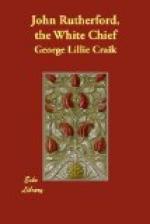Their only missile weapons, except stones, which they merely throw from the hand, are short spears, made of hard wood or whalebone, and pointed at one extremity. These they are very dexterous with, both in darting at a mark, and in receiving or turning aside with the blades of their battle-axes, which are the only shields they use, except the folds of their thick and flowing mats, which they raise on the left arm, and which are tough enough to impede the passage of a spear. They have other spears, however, varying from thirteen or fourteen to thirty feet in length, which they use as lances or bayonets. These, or rather the shorter sort, are also sometimes called by English writers patoos, or patoo-patoos. Lastly, they often carry an instrument somewhat like a sergeant’s halbert, curiously carved, and adorned with bunches of parrot’s feathers tied round the top of it.
The musket has now, however, in a great measure superseded these primitive weapons, although the New Zealanders are as yet far from being expert in the use of it.
By Rutherford’s account, as we have just seen, they only fire off their guns once, and throw them away as soon as they have got fairly engaged, much as some of our own Highland regiments are said formerly to have been in the habit of doing.
Cruise, in like manner, states that they use their firelocks very awkwardly, lose an immense deal of time in looking for a rest and taking aim, and after all, seldom hit their object, unless close to it.
Muskets, however, are by far more prized and coveted by the New Zealander than any of the other commodities to which his intercourse with the civilized world has given him access. The ships that touch at the country always find it the readiest way of obtaining the supplies they want from the natives, to purchase them with arms or ammunition; and the missionaries, who have declined to traffic in these articles, have often scarcely been able to procure a single pig by the most tempting price they could offer in another shape. Although the arms which they have obtained in this way have generally been of the most trashy description, they have been sufficient to secure to the tribes that have been most plentifully provided with them a decided superiority over the rest; and the consequence has been that the people of the Bay of Islands, who have hitherto had most intercourse with European ships, have been of late years the terror of the whole country, and while they themselves have remained uninvaded, have repeatedly carried devastation into its remotest districts.
More recently, however, the River Thames, and the coasts to the south of it, have also been a good deal resorted to by vessels navigating those seas; and a great many muskets have in consequence also found their way into the hands of the inhabitants of that part of the island.
When Rutherford speaks of the two parties whom he saw engaged having had about two thousand stand of arms between them, it may be thought that his estimate is probably an exaggerated one; but it is completely borne out by other authorities. Thus, for example, Davis, one of the missionaries, writes, in 1827: “They have at this time many thousand stand of arms among them, both in the Bay and at the River Thames.”




